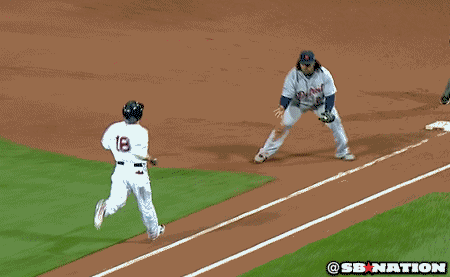A lot can be seen in one play at first base
April 2, 2014 by Coach McCreary
Filed under Base Running, First Base
Take a look at the brief video clip I ran into online. Click on the photo below and then keep clicking the refresh button to see it over again. Then come back to the post to read further.
It only takes a few seconds to watch the clip but there are several things in the clip that both first basemen and base runners can learn from. Obviously, the runner must have hit or bunted a ball right to the first baseman who came up the line to tag the runner out.
First, let’s learn from what Prince Fielder (the first baseman) does on this play:
- Prince Fielder is a very large man so what he does on this play isn’t much of a problem for him. For most other players, it is never a good idea to stand directly in the path of an oncoming runner. Some runners may just give up and casually run into the tag like Shane Victorino but others may try to run through you. That collision would probably hurt for a few days.
- Another reason why standing in the runner’s path is not the prefered method relates to other possible runners. If a runner was on second base and rounding third when contact is made with the first baseman, it will be much harder for the first baseman to break away from the runner, set his feet, and make a strong accurate throw to nail the runner trying to score. A first baseman would be much better off pretending to be a bull fighter and Olé the runner as he goes by.
- On the positive side, Fielder did the right thing by catching the ball and moving forward to tag the runner. That is often quicker than trying to turn your back and beating the runner to first base. When other runners are on base, especially those rounding third, moving towards the runner to tag him keep all the plays in front of him. Turning your back to the infield and all other runners usually is not a good idea.
Now let’s talk about the base running. The only things that need to be said here involve the things Victorino did not do on the play. Here are some:
- He did try to slap the fielders glove to dislodge the ball. Not a good idea.
- He did not try to barrel over the first baseman. Also not a good idea.
- Lastly and most importantly, he didn’t stop running. He should have. When a base runner is in this position where the first baseman is moving forward to tag him for an easy out, the runner should always try to stop and move backwards towards home plate. Yes, you read that right. Stop and start moving backwards towards home plate. Here is the rationale for that. If you are a dead out like the video shows there is no value in just running into the out. Stopping and moving back towards home plate gives you a very small chance of the first baseman screwing up what happens next. A smart first baseman will just continue to jog/walk towards you – all the way back to home plate if necessary – and tag you. A not-so-smart first baseman will try to avoid the extra work and turn to throw to the second baseman who is probably covering first base. Ever see a player turn an easy toss to first into a ball thrown down the right field line? I’ve seen it more times than I care to remember. And that’s why the runner should stop. You try to generate a throw. More throws = more errors.
- Another note about stopping: There may be other runners on base. Let’s say there was a runner on first before the ball was hit. When the runner stops to get the first baseman to chase him, the other runner attempts to go to third base. The first baseman now has to make a decision. Throw to third (longer throw) or tag the runner (may not be close enough to tag him yet). If he makes a poor decision and/or a poor throw to third, both runners could end up safe.
The message for runners in this situation is to give the first baseman more time to screw something up. In the end, it may not work but at least you didn’t give up and make it easier for him.
Tomorrow’s post: Baseball and Wall Street






Leave a Reply